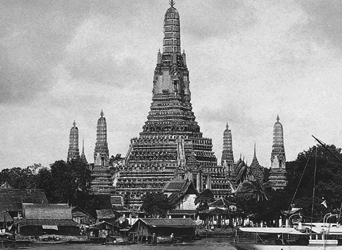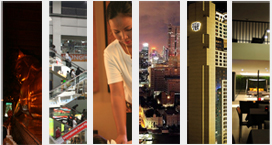Bangkok Brief History
 |
Before the 1780s the vicinity of Bangkok consisted of small principalities which existed without official status. Bangkok began as a small trading community on the west bank of the Chao Phraya River during the Ayutthaya Kingdom,1350 to 1767. The town's name is derived from Bang Makok, bang being the Central Thai name for towns or villages situated on the bank of a river, and makok being the Thai name of Spondias dulcis (a tree producing yellow plum-like fruits).
|
After the fall of Ayutthaya to the Burmese Kingdom in 1767, the newly declared King Taksin established a new capital in the area of then-Bangkok, which became known as Thonburi.
When Taksin's reign ended in 1782, King Buddha Yodfa Chulaloke reconstructed the capital on the east bank of the river and gave the city a ceremonial name which became shortened to its current official name, Krung Thep Maha Nakhon (which means "city of angels"). On April 21st 1782 Bangkok became the capital of Thailand and the seat of the Thai government.
Since the 1780s then much of Bangkok's history has been dominated by the constant renovation of the old temples, palaces, and monuments in the city, as in Thailand it is the divine responsibility of the king to maintain the Buddhism religion.
The early to middle nineteenth century saw a gradual increase of foreigners into Bangkok, missionaries and traders who came from many European countries and North America. By 1860 many traders had formed economic alliances and treaties with Bangkok.
King Mongkut (1851-1868), and later on his son King Chulalongkorn (1868-1910) brought about much development and modernization in Bangkok and Thailand. The city's first paved street was completed under Mongkut's rule and in 1863, his son proceeded to construct new city roads, developing a railway line connect to the north of Bangkok as well creating a tramway.
By 1900, rural market zones in Bangkok began developing into residential districts. The Memorial Bridge was constructed in 1932 to connect Thonburi to Bangkok which was believed to promote economic growth and modernization in a period when infrastructure was developing considerably. During the Vietnam War period of the 1960s increased FDI investment flowed into Thailand, improving the Don Mueang airport and its highways.
Since the 1960s modernization and population pressure with now over 8 million people in Bangkok, traffic congestion and pollution has become a significant problem in Bangkok.
|
 |








